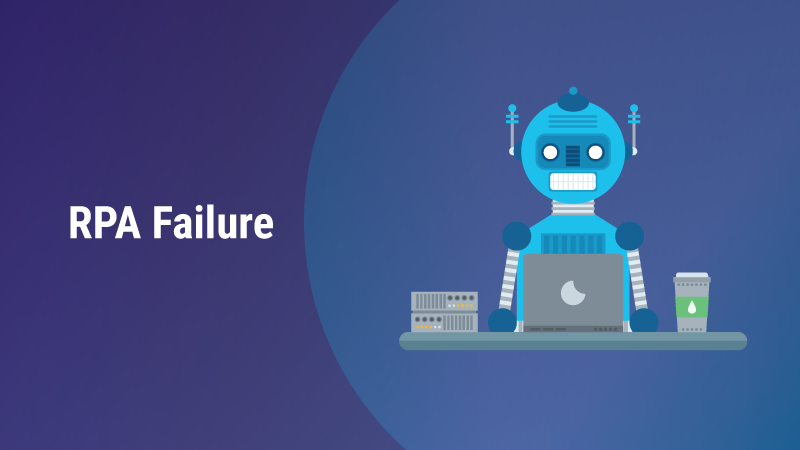Reasons For Robotic Process Automation Failure And How To Avoid Them

Robotic Process Automation (RPA), as a software tool, has brought enormous changes in the field of technology. RPA took the regime of technology to new heights with its capabilities to automate repetitive and monotonous tasks not just in the IT sector but also in various other business sectors including banking, accounts payable, education, health care, Insurance, telecommunications, logistics, real estate human resources, BPO and the list goes on. Completion of tiring and repetitive tasks using manual resources or human employees took a lot of time, effort, and money. RPA along with other sophisticated technologies like Machine Learning (ML), and Artificial Intelligence (AI) has put an end to such manual labor.
So, if such an innovative technology like RPA fails, can you imagine what would be the reason that might have resulted in RPA failure? Let us discuss the reasons for Robotic Process Automation Failure.
Robotic Process Automation Failure: Reasons
If Robotic process automation projects fail, it’s because most people who try to automate their tasks using RPA do not have a proper idea about their work processes. RPA becomes ineffective without a properly defined work process and this is a commonly found challenge while implementing robotic process automation. Mainly there are 2 situations for the failure of RPA
- Either the automated process is not fully robotic as identified or,
- Automation works in a way that is more dynamic than previously defined.
Before implementing RPA in your business, think of the process that needs to be automated and if it needs to be more dynamic or not. It is important to consider these factors to avoid facing RPA challenges later in the future. Here are some elaborate reasons for RPA failure:
The RPA process is more dynamic than expected
If the activity is more dynamic, it should always be checked to see if it is operating in a changing environment and producing precise results. In case of such problems, an organization is expected to seek assistance from an RPA implementation strategy and consulting service, which can fix the problem. If each case requires decision-making on a separate basis, you should include humans and reduce the RPA failure rate.
Lack of clarity in the use of RPA strategy
If any RPA project demands to increase the efficiency of its process without defining how RPA should be used, the risk of it becoming an isolated business activity is very much higher. Therefore, it results in the failure of RPA implementation in the future. Creating a clear picture of the use of RPA software will be helpful as it meets the requirements and expectations of many business functions.
Unrealistic ideas about automation
Technology itself is a work in progress and Robotic Process Automation is one among the many technological innovations that are striving to achieve the desired results. But people fail to realize this and expect their software bots to fix all existing process issues. The truth is that most of the time, all these unrealistic ideas are the major reason behind the failure of RPA. For example, RPA is used in telecommunications but as of now, no software bot can pick up a call and talk to people like human employees do. What bots can do is record the conversations via calls and chat, hand it over to customer care executives when they can’t solve it, and manage post-call processes. Successful implementation of RPA starts with understanding its capabilities and way of functioning.
Use of the wrong RPA solution for a work process
Initially, most software robots worked in the back office unnoticed. They were working according to the pre-determined rules, doing routine jobs behind the scenes with zero supervision. RPA software was mainly built for this purpose and was compatible with most projects of the time. Things changed when robotic process automation was brought to the front office and started collaborating with new RPA vendors and solutions. RPA works best in areas where activities are monotonous such as in the retail or packaging industries where human interference or judgments are not required. RPA is not the perfect fit for processes that need human intervention to complete the task and if such scenarios happen, that marks the failure of RPA projects.
Lack of instructions and memo
RPA is really good when it comes to following the instructions given to the bot for each process concerned, but it lacks behind in its ability to understand and learn things on its own and react to unexpected scenarios. Therefore, we need to witness the growth of work processes where RPA is deployed. RPA bots are incapable of working in situations or projects in which they are not given instructions or training. This mostly results in the failure of the project.
Poor change management communication
What most companies fail to think before starting on their RPA journey is about their culture of adapting and supporting changes in their working environment. Adopting new technologies, especially RPA, not only changes the way individuals do their work but also changes the overall behavior of the company. So, there is a need to communicate the changes brought to the company and address employee concerns, which are essential for the success of RPA implementation and further growth of the company. Another important thing is training the skills of the staff and helping them to navigate the newly adopted human-bot culture in the organization. It is important to make sure that your staff understands the working of RPA technology, the development of bots, and their performance efficiency.
Wrap Up
In most cases, the vast majority of robotic process automation (RPA) project failures are caused by people. The inappropriate way of understanding the functioning of RPA and the way people execute their operations are some of the most common causes of Robotic Process Automation failure. The aforementioned reasons made it clear that RPA trying to automate complex and difficult processes within a single solution can result in making various errors in businesses. Therefore, a proper approach is essential.
Get Started with our RPA Services0 thoughts on “Reasons For Robotic Process Automation Failure And How To Avoid Them”
Leave a Reply
Blogs by Category
AppForms Artificial Intelligence Blockchain Call Centers Chatbots Cloud Computing Data Management Design Digital Marketing Digital Transformation Enterprise Applications FinTech Insights LowCode Development Microsoft Mobile Apps News Office 365 Robotic Process Automation Security SharePoint Software Development Web ApplicationWhat is Robotic Process Automation? RPA Explained

2024-05-23 16:56:57
Hey Arvind,
Thanks for this article.
I need some information for documentation. I am looking for all the reasons because of which a RPA solution developed using MS Power Automate fails. Along with this I need their % of contribution for the total failure. Need this information for ascertaining the most likely failure we can expect. Most importantly I need a URL that can be quoted to support this information. Would appreciate if you can share me this information. Or at least point me to resource where I can find. I tried looking for different reports, articles, community forums, etc. None of these were of any help.